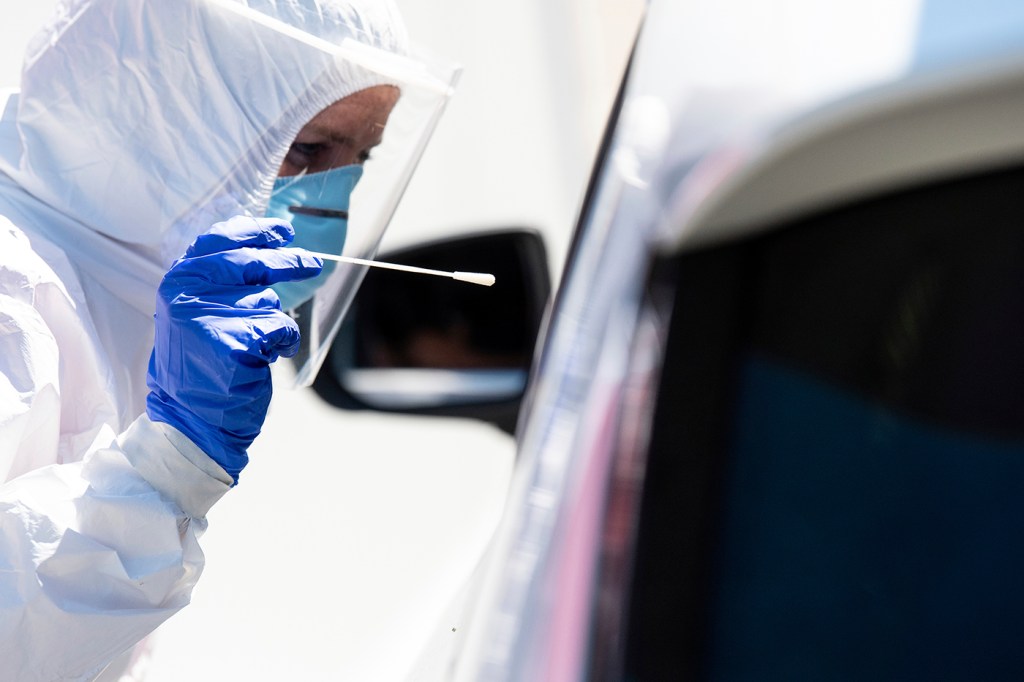Timely test results are necessary to slow the coronavirus. But a new study shows critical delays across the US.

More than 63 percent of U.S. residents are waiting longer than one to two days to get their coronavirus test results—delays that undermine the contact tracing that could identify individuals who are contagious but show no symptoms, according to results of a new survey by researchers from Northeastern, Harvard, Northwestern, and Rutgers universities.
Overall, the average wait was four days, but in some cases grew to as long as ten days or more for about 10 percent of respondents in a study. The discovery is significant in that health authorities consider rapid turnarounds essential to containing the COVID-19 pandemic, which has so far resulted in the deaths of more than 150,000 in the United States.

David Lazer is university distinguished professor of political science and computer and information sciences with joint appointments in the College of Social Sciences and Humanities and the Khoury College of Computer Sciences at Northeastern. Photo by Adam Glanzman/Northeastern University
Even more worrisome is that wait times do not seem to be diminishing across the country.
“Given the timing of how quickly and how long someone is infectious, speed in producing reliable enough results is of the essence for COVID-19,” researchers wrote.
A delay of even a day is critical given that the peak of contagiousness lasts about one week. In that time, scores more could be infected with SARS-CoV-2, the coronavirus that causes COVID-19, if they come in contact with someone who may seem healthy, making a positive test virtually useless.
“This is definitely a case of closing the barn doors after the horses have escaped,” says David Lazer, university distinguished professor of political science and computer and information sciences at Northeastern, and one of the researchers who conducted the study.
“It’s too slow for contact tracing and isolation to be effective.”
The study of 19,058 people across all 50 states and the District of Columbia was conducted between July 10 and July 26, 2020. It asked residents if they had been tested for COVID-19 and how long they waited to get the results back.
It found that 37 percent of those who had been tested by nasal swab received results within two days, with 31 percent taking more than 4 days. For individuals who responded that their last test had been in April, they had waited on average 4.2 days to get results; for those who were tested in July, it was 4.1 days.
Transmission by people who are infected but have no symptoms (either because they will never develop significant symptoms or are presymptomatic) is a key driver behind the spread of COVID-19 because such people are more likely to go about their lives without adopting measures such as quarantining to stem transmission to others.
“If individuals with COVID-19 simply manifested with a purple nose before they were contagious, the disease would be easier to contain and would quickly disappear,” the researchers wrote. “Testing is the functional equivalent of that purple nose.”
Reasons for delays in getting test results out faster invariably point to a bottleneck in national testing labs, says Lazer. “They are simply overwhelmed.”
One solution to the challenge could be at-home tests, which have yet to be approved by the Food and Drug Administration. They have greater false negative rates but appear to perform better for individuals who are shedding more virus, says the study.
In terms of demographics, researchers found that Black and Hispanic people are waiting five days for their test results compared to four days for white respondents, a difference that could be explained by resources and local conditions in their communities, according to Lazer.
In separate, COVID-19-related studies, the universities’ researchers reported that the pandemic is resulting in higher support for voting by mail among likely voters.
The July study found 64 percent are in favor of making it easier to cast ballots by mail, and an even larger number (66 percent) say they would support giving every American the universal right to vote by mail in November, an effort opposed by President Donald Trump because of the potential for fraud.
Approval of the president’s handling of the pandemic is down 10 points since April, the latest findings show. Some Republican governors of states that reopened early–and that have faced surges in COVID-19 infections–continue to see declining approval numbers, mirroring the president’s pandemic-related approval in those states.
For media inquiries, please contact media@northeastern.edu.





